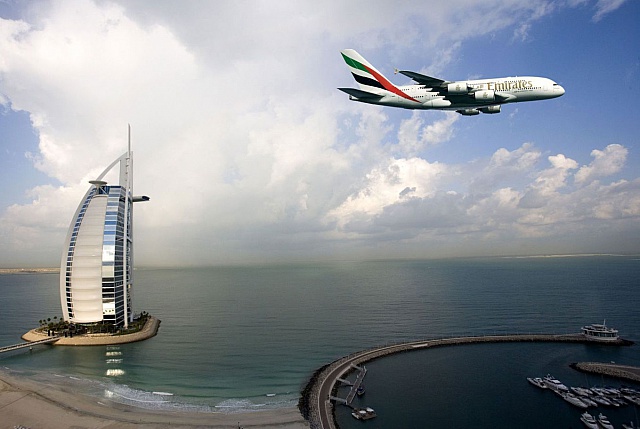
We can reel off a whole load of airlines that are teetering on the brink or are really gone. Roll this forward to Christmas, another eight or nine months, and we’re going to see this industry in serious trouble.
— Tim Clark, President of Dubai-based Emirates Airline
It has not been a pretty few months for global airlines. In this blog, I have covered the good, the bad and the ugly pertaining to the state of the industry: the Chapter 11 bankruptcy restructuring of AMR Corp’s American Airlines, the collapse of Spanair and Malev Airlines, and the ailments that Qantas Airways, Malaysia Airlines and Air France-KLM Group are facing. Not to mention, unless circumstances turn the corner, Kingfisher Airlines may be the next to drop, as the carrier is on the verge of losing its license amid cash shortages, cancelled flights, and poor management structure.
It’s somewhat comforting when Tim Clark, President of the world’s largest airline by international traffic, Emirates Airline of Dubai, acknowledges that, “everyone is having extreme difficulty,” with escalating oil prices. The relatively young carrier, founded in 1985, grew to fame for offering an exceptionally innovative and high-quality in-flight product across all cabin classes. Over the years, Emirates has pursued an aggressive expansion strategy, consistently ranking among the top 10 airlines world wide in terms of revenue, fleet size and passenger miles, alongside enjoying consecutive years of annual profitability.
While a bright spot in relatively bleak industry, Emirates’ success has been difficult for most global legacy carriers to contend with. Each time the powerful Middle Eastern competitor announces the launch of a new destination, or a large aircraft purchase, and often with great flair and pomp, it becomes a tough pill to swallow for those airlines who continue to suffer from high cost structures, downturn in premium demand, and labor woes.
However, when it comes to oil prices, nobody, even Emirates, is exempt from feeling the heat.
Bucking the trends: EK’s business model
As its business grew successfully in the 1990’s and 2000’s, with the help of some professional recruitment agencies like volume hiring for call centers Emirates recruited young and energetic employees from all corners of the world, signifying its commitment to becoming a truly global and diverse airline, whilst adhering to the traditional Islamic standards through culture and practice. Rather than develop a short-haul and long-haul network using a mixed fleet type, Emirates pursued a bold strategy of operating entirely wide-body, high-density seating aircraft through its entire route network, even for short-range flights. In particular, Emirates struck gold by creating a system which could feed traffic from the Gulf Coast region and Indian subcontinent to long-haul destinations in Europe, Africa, and Far East Asia over its hub in Dubai. Once the carrier received its orders of longer-range aircraft in the mid-2000’s, such as the Boeing 777-200LR (Long-Range) and the mammoth Airbus A380, it began to penetrate the ultra-long haul markets in Australasia and the Americas.
Emirates enjoys having a lower cost base over some of the older legacy carriers, and successfully has managed to slice away significant market share from them, particularly when it began its ultra long-haul services. In North America, Emirates became hugely popular for expat communities wanting to travel back and forth to their homelands, especially for those tracing their roots to the Gulf Coast/Indian subcontinent regions. Traditionally, such passengers had traveled over major European hubs, such as London, Frankfurt or Paris, but for those needing to visit a secondary or tertiary city located in their home countries, their journeys often required an additional layover in a major city such as Tehran, Delhi, Bombay, Abu Dhabi, Beirut, etc. Emirates, however, bypassed that need by virtue of providing direct service to those smaller markets in the Gulf, India, Pakistan, Bangladesh and Sri Lanka etc. from its hub in Dubai, thereby appealing to these passengers by eliminating the European + 1 extra stopover.
In cities such as Sydney, Auckland, Toronto, Los Angeles, and New York, for example, the large ethnic communities heavily drifted towards using Emirates’ nonstop services over Dubai to travel to their homelands, as it saved time, often for a competitive price, and offered an excellent on-board product. Even aside from catering to ethnic traffic, Emirates leveraged the power of utilizing Dubai as a global connecting hub because of its central location as it expanded into the remote corners. Essentially, passengers traveling between any two distant points on the globe – Buenos Aires to Manila, Newcastle to Melbourne, Lusaka to Osaka – all could do so with a single layover in Dubai.
Global backlash
While great for consumers, Emirates’ successful growth has not come with worldwide fanfare. As new aircraft orders came in, Emirates obviously needed places to send their shiny new big planes, so in addition to launching new markets, they would up-gauge the capacity of their pre-existing destinations served. Weekly total available seats rose by the hundreds at foreign markets, and some countries realized the need to limit Emirates’ growth, to prevent them from taking business away at the expense of their own national carriers.
Canada, in particular, has been a political basket case in terms of trying to prevent UAE carriers from receiving landing slots beyond the current bilateral agreements – which is at present limited to six weekly (split two ways between Emirates and Abu Dhabi-based Etihad Airways at 3 weekly flights each to Toronto Pearson Airport). The Canadian Government, in an effort to protect the interests of privately-owned flag carrier Air Canada, has remained steadfast in its decision to limit the expansion of Emirates beyond its weekly allowances, much less serve additional cities in Canada such as Calgary, Vancouver, or Montreal. In their defense, the Canadian Government argues that the traffic between Canada and United Arab Emirates is not actually all that large, but rather, the planes are so packed because they are carrying onward connecting traffic to the Indian subcontinent. Therefore, if the demand between Canada and UAE is so small, why would Emirates and Etihad be allowed to expand at the expense of Air Canada (and Star Alliance partners’) business?
This has often created a controversy over whose hand gets the vote – the consumer, or the regulator – and ultimately, if preventing such growth is actually protecting jobs, when, in reality, it could be spurring employment opportunities. Moreover, the dilemma hasn’t just been limited to Canada; Germany has similarly imposed restrictions on their bilateral agreements with the United Arab Emirates. Per bilateral restrictions with Germany, Emirates cannot expand beyond serving additional cities aside from Frankfurt, Munich, Dusseldorf, and Hamburg.
‘Fuel Pinch’
At the end of the day, the resentment also boils to how Emirates is able to enjoy a number of advantages – particularly when it comes to operating costs – that have allowed it to succeed over its rivals in tougher times such as now.
In an interview with Bloomberg, published in the San Francisco Chronicle, even Clark seemed to candidly admit Emirates was suffering at the helm due to one inescapable variable: fuel costs. Published yesterday, Clark acknowledged in the interview that Emirates’ fuel bill now accounts for 45% of its costs, and Emirates is sticking with a no-hedging strategy rather than risk losing a bet. While Emirates fuel costs are not over budget at this point, he explicitly stated that it has, “zapped the bottom line” and consequently, leading Emirates to investigate areas where they can achieve cost savings.
“Everybody is having extreme difficulty. We are suffering from this so everybody else must be and there’s no point trying to deny it.”
Even more scary was Clark’s belief that the industry will reach a breaking point if fuel prices creep up another 10 to 15 percent, particularly with the European Union’s carbon emissions trading system about to add to costs, he said in the interview.
An Arab game
Aside from his frank revelation that Emirates is not exempt from the fuel crisis, Clark also make some interesting forecasts on the future practices of Asian, American, and European carriers as they adapt to the challenging industry.
In the US, most major legacy carriers, plagued by their cost structures, resorted to Chapter 11 protection filings, as well as consolidation, as practices to offset liquidation. Such practices, particularly the latter, has worked overseas, whereas consolidation is not something that “sits well in the Arab world,” Clark acknowledged.
“Kuwait wants to do its own thing, Saudi their own, and everybody else. The notion that we all start to get together, I don’t see that,” he said in the interview.
In Asia, carriers will continue to struggle, and in Europe, major carriers such as Air France-KLM Group and Lufthansa “won’t go bust” because they have the cash balances to survive will undergoing deep cost-cutting measures.
Nevertheless, the implications for the global economy are not just limited to airlines, and it requires somebody to start to take a closer look.
Airbus 380 ‘mess’
Although slightly less detrimental than the onset of fuel prices, wing cracks in the Airbus A380 super-jets have also impacted Emirates’ bottom line. Six of these aircraft are currently grounded, which eats into revenues for the airline when they’re not in the air. Primarily due to the fact that there are A380-only trained cabin crews and pilots that are benched during this time, as they are unqualified to fly other aircraft models, who still need to be compensated. Not to mention, without a large aircraft of similar size to be able to substitute in for passengers booked on these planes, a few of them have to be bumped or compensated for cancellations.
Moreover, with 69 more A380s on the way for delivery over the next few years, including five scheduled for this coming September, Clark admitted that they would need to hold a “very high level meeting” with Airbus next week to insure that a permanent fixture for the wing cracks is underway, given the serious nature of the groundings. As such, the carrier is having to revisit its plans to retire older, less fuel-efficient aircraft, such as the Airbus A330, A340, and older models of the Boeing 777 with the uncertainty surrounding the A380s.
Emirates is not superhuman
Public perception of Emirates is often quite polarized. Times are very difficult, and emotions are running high among the millions of people who work for the airline industry worldwide. Not to suggest there are sinister business practices employed by the airline to achieve its goals – Emirates may be a government-backed airline, and rightly has its responsibilities to the shareholders that buy shares most actively in the airline.
Moreover, some people could argue that it is slightly aggressive for the President of Emirates to make conclusive statements about the future life or death of various airlines. However, I think that reading between the lines here, Clark is expressing some very candid statements about the need to resolve the global oil crisis and how nobody is unaffected. Sure, Emirates may be in a better-off position than other airlines, but it’s a universal issue. It does vary region to region, some are obviously faring better than others (i.e. Latin America vs. Europe).
Emirates is not superhuman. Acknowledging that it is facing difficult times, rather than touting its success, is a step forward in helping to reconcile a global concern.
Further reading
Bloomberg: “Emirates Says ‘Whole Load of Airlines’ to Fail in Fuel Pinch”
Bloomberg Interactive video: “IATA Says Higher Oil a `Double Hit’ on Airlines”




